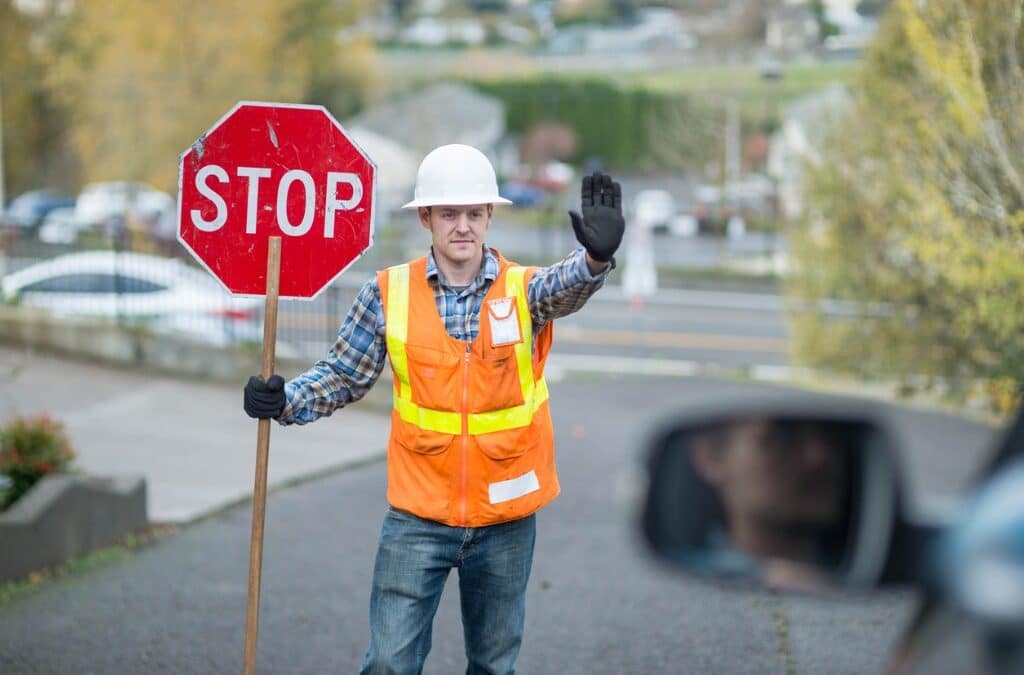Road and highway construction workers are essential for ensuring the creation and safety of new roadways and highways. Without well-maintained roads, commuting to work, traveling for vacations, and day-to-day transportation would be nearly impossible.
With more drivers on the road each day, cities and states across the US are starting more road construction projects to keep their roads safe and efficient for drivers and pedestrians. However, working in heavy traffic can potentially lead to regrettable accidents and fatalities, which means it’s imperative that road construction workers are safe while on the job.
Familiarizing your crew with essential road construction safety tips helps keep everyone aware of hazards and keeps them better-prepared to perform their work each day. In this article, we’ll look at some common causes of road construction injuries, hazards to be aware of, and five road construction safety tips to keep your crew safe.
Continue reading below to learn more about how to ensure the overall safety of your road construction workers and how TCS Upfitting can help you increase the safety of your road construction workers.
The Most Common Road Construction Hazards
Every road construction project has its own set of challenges, dangers, and possibilities that must be appropriately considered before work begins. As a result, it’s crucial that road construction workers are well prepared by learning about the various causes of construction accidents.
Let’s look at some of the most common road construction hazards that workers face.
Collisions
Collisions involving construction equipment and nearby traffic are common causes of road construction injuries and fatalities. Taking precautions, such as locking mobile equipment in place, maintaining clear and frequent communication with equipment operators, and remaining aware of your surroundings, is the best way to avoid collisions.
Slips and Falls
Another common cause of road construction injuries is slips and falls. According to the US Department of Transportation (DOT), slips and falls account for 20% of road construction injuries. Workers can avoid these hazards by avoiding muddy, damp, or snowy conditions and filling in or identifying hidden hazards in or around the construction site.
Weather-Related Accidents
Working in inclement weather conditions is an unavoidable hazard of road construction. Not only does extreme heat increase the risk of heat-related problems, but winter weather can impair visibility and mobility. Each scenario necessitates various precautions, but identifying symptoms of cold or heat stress, limiting the time worked on hot or cold days, and providing adequate breaks in between work can help limit issues caused by harsh weather.
Struck-By-Object Accidents
These incidents are prevalent on road construction job sites and include vehicle and equipment strikes, pieces of equipment overturning, rigging failure, and loose debris. As a result, it’s critical that workers maintain awareness of their surroundings and wear high-visibility apparel, such as vests and hard hats, to avoid these incidents.
Caught-In/Between Accidents
Caught-in or between accidents occur during equipment rollovers, excavation collapses, or whenever a worker is crushed or stuck between two objects. Maintaining properly guarded excavation protection systems and equipment is essential for reducing caught-in/between injuries.
5 Road Construction Worker Safety Tips
Every aspect of road construction can be dangerous if workers don’t know what to look for or how to use their tools or equipment correctly. While identifying hazards is an essential component of workplace safety, providing safety tips to your road construction workers can help ensure that your crew fully understands how to stay safe in road construction work zones.
Here are five road or highway work zone safety tips to help your team stay safe on the job.
Implement Proper Training
Before entering the worksite, ensure that your workers have received all relevant safety training, including how to operate the tools and equipment, what the site-specific work zone hazards may be, and what to do in the case of an emergency. One of the best ways to ensure your crew is on the same page is to hold a safety meeting before the workday begins.
Because conditions in the work zone might vary substantially from day to day, workers should be briefed on the work activity scheduled each day and notified of any potential hazards. This is also an excellent time to emphasize the importance of safety on the worksite, and ensure each worker has the necessary instructions for the day’s activities.
Avoid Blind Spots
Vehicles and heavy machinery, such as dump trucks, compactors, pavement planers, excavators, pavers, and rollers, constantly move throughout the worksite. Furthermore, drivers and equipment operations have a limited line of sight if you are on foot and working nearby.
As a result, it’s crucial that road construction workers maintain visual contact and understand communication signals to ensure everyone remains visible to each other. Additionally, heavy equipment operators must ensure that all mirrors and visual aid devices, including backup alarms and lights, are correctly attached and operational.
Stay Hydrated
Staying hydrated is essential at all times, regardless of the weather. Whether working in humid summer heat or cold winter conditions, it’s easy to become dehydrated on construction job sites. While there are numerous ways to prevent dehydration, including learning the signs of heat-related illnesses and providing enough water for your crew members, it’s crucial that all employees keep a caring eye on each other throughout the workday.
Establish Perimeters and Work Areas
Ensuring adequate space for everyone to work safely is another crucial component of road worker safety. Road construction work zones are typically active areas with multiple work activities occurring simultaneously.
To avoid accidents, be sure to utilize cones, barrels, and barricades to clearly distinguish certain areas of the work zone. These could be areas for material storage, where heavy equipment is being used, vehicle parking, or safe zones for workers on foot to move around within.
Wear Adequate Safety Equipment
The Occupational Safety and Health Administration (OSHA) requires all road construction workers to wear safety equipment, such as hats/helmets, vests, goggles, gloves, boots, and reflective or high-visibility clothing, to ensure they are visible to others on the road and within the job site.
Additionally, crew members should also ensure that all safety equipment fits properly, and safety inspections should be completed to ensure the equipment meets or exceeds specified safety standards.
While traditional warning lights have been used to mark work zone areas, many workers are still vulnerable to accidents, as they cannot be seen in low-light conditions and heavy equipment blind spots. One of the best pieces of safety equipment to prevent workplace accidents involving construction workers is the ACARI UV from ACARI Fleet Solutions.
The innovative ACARI UV Warning Light utilizes ultraviolet and amber light to illuminate individual workers, make them more visible to drivers at night, and provide a safer job site. The ACARI UV can also be easily integrated with existing safety equipment to take worker safety to new levels.
Count On TCS Upfitting to Keep Your Workers Safe
Workplace safety in road construction work is something that all crew members must take seriously. When safety rules are not followed, and workers fail to take simple precautions, accidents are more likely to occur. While eliminating all causes and risks of road construction injuries is impossible, adhering to strict road construction operating procedures and safety standards can significantly reduce the risks your workers face.
At TCS Upfitting, we’re committed to outfitting your work vehicles with the proper equipment to ensure your company’s success. Our team of highly skilled experts understands the importance of high-quality craftsmanship, and we work closely with you to ensure complete satisfaction while assisting you in upfitting your work vehicles.
With over 15 years of unrivaled experience in commercial vehicle upfitting, we proudly stand behind our work, and we remain dedicated to maintaining a high level of standards and professionalism while providing quality products that meet and surpass your expectations.
To learn more about how TCS Upfitting can unlock your company’s full potential, contact us today to speak with one of our commercial vehicle upfitting experts about how we can assist you.


